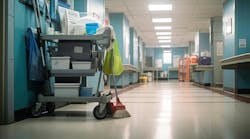Like many higher-education institutions, the University of Massachusetts - Amherst, experienced significant growth in the 1950s, '60s and '70s.
"About 80 percent of our space was constructed during that time," says Jim Cahill, the university's director of facility planning.
Over the years, construction was made a priority and maintenance was put off, resulting in most of the campus' 9 million square feet of space not getting the attention and repair it required.
The result? By the late 1990s, the backlog of maintenance on the Amherst campus was estimated at $400 million.
"We had a huge deferred maintenance liability," says Cahill. "We felt compelled to get on top of it."
The numbers may be different at other campuses, but the general scenario is familiar to countless colleges and universities. Aging buildings, many of them constructed quickly a generation ago to meet enrollment spurts, need fixing. In most cases, the need outstrips the available revenue, so projects are postponed. The needs grow, and problems that are not fixed promptly cause more deterioration. Soon, a school is in a deferred maintenance hole so deep it has no way to escape.
Like their counterparts in K-12 education, colleges and universities are scrambling to tackle the critical problem of deferred maintenance in their facilities. To do so, facility officials must convince the people who control the purse strings at their institutions - the university's own administration, state legislature, charitable donors - that the consequences of continuing to defer the problem could be dire.
Money for repairs
As awareness of the problem has grown and a healthy economy has freed up more resources, colleges and universities are able to spend more money to repair or replace their aging facilities. American School & University's most recent Official Education Construction Report (May 2000) found that colleges spent more than $13.9 billion on projects completed in 1999 - $8.4 billion on new construction, nearly $2 billion on additions and $3.5 billion on modernizations. Projections for 2000 to 2002 show total spending on college construction of $32.5 billion - $22 billion for new facilities, $4.5 billion for additions and $6 billion for modernizations.
In Nebraska, officials at the state's university system and leaders in state government have worked together to address facility needs on the four campuses in the University of Nebraska system.
"It has been a partnership from the beginning," says Rebecca Koller, director of planning for the university.
The university estimated it had a backlog of more than $110 million in deferred maintenance.
"Many of the University of Nebraska's facilities were built more than two or three generations ago and some are approaching the point where they may have to be closed because of general disrepair, unsafe physical conditions, improper air-handling systems, and noncompliance with fire, safety and ADA codes," says a university report. "Over the years, competing budget priorities and limited resources have not allowed for sufficient funds to repair or replace major building infrastructure."
The solution was two-pronged: addressing the most urgent maintenance needs quickly and aggressively, and a more gradual increase in maintenance budgets so the campuses could deal with repairs and replacement as the needs arose.
The $95 million initiative was signed into law in 1998. The state increased allocations to the university by $5.9 million for 10 years to help pay off bonds issued for repair projects. In addition, the university increased tuition to cover the costs of the maintenance plan.
To bolster its ability to keep on top of repairs, the university also committed to increasing annual expenditures on building maintenance by $1 million a year for 10 years until the maintenance budget equals 1.5 percent of the replacement value of the system's buildings.
Koller says projections show that under this plan, the university could eliminate its backlog by 2015.
Persuading with facts
At the University of Massachusetts - Amherst, officials knew their deferred maintenance problem was critical, but with 9 million square feet of space in 190 buildings, the task of amassing data to get an accurate reading of the problem was daunting.
About three years ago, says Cahill, the school decided to bring in a consultant to conduct a comprehensive audit of the campus facilities that would evaluate the condition of buildings, prioritize repair needs, and project how much money the university would need in the long- and short-term for eliminating the backlog.
The detailed data compiled and the software system used to keep track of it allowed the university to substantiate its needs and do modeling to show what could be accomplished with various levels of funding. That information, combined with an overall strategic plan for the university that made facilities a top priority, gave officials the direction they needed to face its deferred maintenance backlog head on.
"It's already at an unacceptable level," says Cahill. "If we didn't do anything, it would only grow worse. With the information detail and a strategy to go forward, you can begin to see it isn't hopeless."
Based on the audit, the school established two main priorities for repairs: protecting the building envelope, and ensuring health and safety.
With software showing officials the most cost-effective way to pursue repairs, the university changed how it went about projects. For example, instead of fixing roofs on 10 buildings, it might do more comprehensive repairs - fixing windows, bricks, drainage - on five buildings.
"That way, instead of just affecting the top floor, the repairs affect the whole building," says Cahill. "The repairs are more noticeable, more visible."
With specific information, facility officials at the University of Massachusetts were able to persuade their administration to commit more funds to repairs and modernization. The school's goal is to increase spending on the deferred maintenance backlog to $12.5 million from $7 million, as well as setting aside $15 million a year for renewing facilities so they can maintain their value. Another goal is to boost spending on modernization to $18 million a year from $7 million a year.
SIDEBAR: Living in the "Swing Dorm"
Parents of students at Yale University might be taken aback at first when they learn their children will be taking up residence in the campus' "Swing Dorm."
But they shouldn't worry - the name doesn't describe the predominant lifestyle in that residence hall. Instead, it describes its role in Yale's extensive efforts to renovate and remodel aging facilities on its New Haven campus.
The university built the "Swing Dorm" - officially called the Yale Residential Building - to provide temporary quarters for students displaced by renovation of the residential colleges they attend.
Yale has 12 residential colleges. By the 1990s, most of the facilities were more than 50 years old and needed extensive modernization. In 1997, the university's five-year fund-raising effort, The Yale Campaign, concluded with $1.7 billion in donations - $424 million of that total was earmarked for facilities.
The university considered scenarios that limited renovation to summer months, but eventually it determined the best approach was to build an additional residence hall. Students would live in the building on a revolving basis while their "home" colleges were being renovated.
In 1998, students in Berkeley College became the first to live in the new residence hall. They were followed by students from Branford College in 1999. This school year, the "Swing Dorm" is home to students from Saybrook College.
A spokesman for the university says Yale will use the Residential Building this way for the next several years. The school has not decided how it will use the building once it has renovated all the residential colleges.

